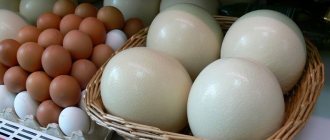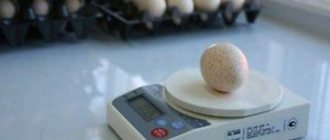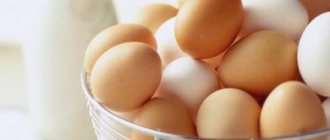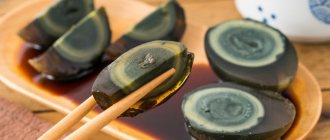How much does a chicken egg weigh?
Testicles obtained from chickens are used for food all over the world. This product is consumed both boiled and raw, fried or dried. The ratio of yolk, white and shell in one chicken egg directly depends on its weight.
White and yolk weight
Approximate mass of chicken egg white and yolk:
- yolk weight: 30-32% (12-18 g);
- protein weight: 56-58% (24-35 g).
These indicators depend on several factors: the number of yolks, product weight, variety (category).
Shell weight
The approximate ratio of the shell is about 10-11% of the total mass of the testicle. The minimum weight of eggshells can be 3-4 g, the maximum - up to 10-12 g.
INTERESTING! It is easy to calculate the weight of a peeled egg without a shell; to do this, you need to subtract 10% from the weight of the whole egg.
How much does a raw and boiled egg weigh?
During cooking, the amount of product does not change in any way. This means that the mass of one egg in the raw and boiled state will be the same. The weight of a cooked boiled egg will change only after peeling it, and it will decrease by 10-11% (shell weight).
How to increase egg production?
Increasing the egg production of chickens will only be possible if optimal conditions are created for them. But the transition from normal conditions to new ones should be gradual so as not to injure the bird. Diet has the greatest influence on egg production. It needs to include the following components:
- Additives for chickens. These are chalk, limestone, shells. You can even make nutrients from eggshells. Such components also have a positive effect on the quality of eggs.
- Protein foods are also beneficial for egg production. In addition, it strengthens the chicken's immunity. For this purpose, mashes are made with the addition of dairy products, legumes or fish oil in small quantities (excess of it can cause the taste of eggs to deteriorate).
- To achieve increased egg production, chickens need to be given a sufficient amount of carbohydrates. They are found in potatoes, grains, wheat, carrots.
- Stimulation of egg laying occurs under the influence of vitamins. Therefore, in the summer they need to be given grass, and in the winter - hay.
If you are interested in how to increase the egg production of chickens on a farm or at home, a special role should be given to the feeding regime.
First of all, you need to create the best conditions in the chicken coop
They need to be given food three times a day at the same time. The first feeding is carried out immediately after sleep, the second - at lunch, and the third - shortly before bedtime. Chickens should be well fed before going to bed.
To increase egg production, you should also create optimal conditions in the chicken coop. Drafts should not be allowed, especially in places where egg laying occurs.
How many eggs chickens lay per day largely depends on the number of nests. After all, if there are a lot of them, then the hens do not have to fight for a laying site, which has a positive effect on their emotional state.
The air temperature in the chicken coop should be 25 degrees. Therefore, in winter it is necessary to heat here, and in summer to ensure normal ventilation. The chicken coop should not be too large, as birds like compactness. The door should be made small so that a lot of heat does not escape from the room.
Increasing egg production will only be possible when the chicken coop is clean.
It is especially important to pay attention to the cleanliness of drinking bowls. Water should not sit in them for more than a day. What else does egg production depend on? Rest is important to them
Therefore, the duration of daylight should in no case exceed 14 hours.
What else does egg production depend on? Rest is important for them. Therefore, the duration of daylight should in no case exceed 14 hours.
Thus, raising birds at home is not particularly difficult. But before you begin, you need to study the question of how to increase the egg production of laying hens. After all, for this they need proper care. If it is not possible to create optimal conditions for them, then you should not hope that the chickens will produce a lot of eggs.
Weight of domestic eggs by category
A domestic egg, the weight of which is indicated in the table, may have a different category.
| name of category | Marking | Weight in grams |
| Third | 3 | 35-44,9 |
| Second | 2 | 45-54,9 |
| First | 1 | 55-64,9 |
| Selective | ABOUT | 65-74,9 |
| Higher | IN | from 75 |
Markings corresponding to the mass are applied to the shell in the form of numbers or letters.
Weight of imported eggs according to labeling
You can find out how many grams are contained in one imported egg by looking at the labeling.
| name of category | Testicle size | Weight in grams |
| S | small | less than 53 |
| M | average | 54-63 |
| L | large | 64-75 |
| XL | very large or extra | over 76 |
In addition to letters, there may be numbers on the shell that indicate the country of origin of the product and the method of raising the bird (cages or floor keeping).
What determines chicken productivity?
Poultry comes in several varieties: meat, decorative and egg.
If the breed is productive, lays a lot of eggs, but they are all small and weigh little, then their cost will be low. Consequently, keeping such birds will be unprofitable.
It is worth noting that a chicken egg is one of the most valuable and frequently consumed goods. It is rare to find dishes that do not contain eggs. Salads, soups, baked goods - all dishes contain proteins, yolks, or both.
Women even use raw eggs for cosmetic masks, because the product has a rich composition, the components of which have healing and rejuvenating properties. They contain vitamins and microelements.
What do numbers and letters mean?
Chicken eggs of different weights of domestic production have the following letters and numbers indicating the category and type:
- B – highest;
- O – selected;
- 1 – first;
- 2 – second;
- 3 – third;
- D – dietary;
- C – dining room.
INTERESTING! Additional information is applied to the shell: sorting date, type and category. For example, a table product of a selected weight category will be labeled “CO”. But it should not be confused with o (grade zero), since it does not exist.
Imported manufacturers use different markings:
- XL – extra or very large;
- L – large;
- M – average;
- S – small.
The numbers on imported eggs may indicate the country of origin and the conditions of keeping laying hens (cage, floor, free-range, etc.).
Other designations
Additional symbols are designed to attract the attention of the consumer. The trend to choose healthy foods is driven by the fashion for a healthy lifestyle
Today, manufacturers adjust ordinary products to fit it, using tricks that are invisible to the gullible buyer.
Village products in the store
Supermarkets work only with large suppliers who are able to pay decently for advantageous shelf space and provide the required volumes of products.
The attractive name “Village”, accompanied by a picture of chickens peacefully walking on a green field, is purely a marketing ploy.
Environmental friendliness
Eco-labeling is only possible for products whose production meets strict international and national requirements.
The oldest signs on the market indicate an increased level of product safety for the environment, but not all of them are used for food products.
These include:
- "Ecosign", European Union;
- "Blue Angel", Germany;
- "Environmental Choice", Canada;
- "White Swan", Scandinavian countries;
- "Eco-sign", Japan.
There is no unified eco-labeling system in Russia. Analogues of European variations are the icons:
- "Eco";
- "Bio"
The legality of their use in most cases remains on the conscience of the manufacturer.
- In theory, such labeling should mean that the product is produced without the use of pesticides, hormones, fertilizers and growth stimulants.
- The use of GMOs and any veterinary drugs, including antibiotics and vitamins, is also excluded.
- Raising poultry to obtain such an egg is required in regions that are not exposed to high doses of radiation and free from other contamination.
The prefix “bio” means that laying hens should roam freely around the pasture without lack of natural feed. A dozen eggs obtained under such conditions cost disproportionately more than usual.
Whether to trust labels for similar products sold at average prices is an open question.
How much do other birds' eggs weigh?
Eggs obtained from different birds can have the following average weight (in grams):
- quail – 10-13;
- guinea fowl – 43-47;
- pheasants – 58-60;
- turkeys – 70-75;
- ducks – 75-90;
- geese – 160-200;
- ostriches – 650-1000.
The eggs most often used for food are those obtained from chickens, turkeys, quails, ducks and geese.
Why are eggs sold by the piece and not by weight?
There are several reasons why eggs are sold not by weight, but by the piece:
- The weight decreases during storage as moisture evaporates through the pores in the shell.
- This product is very fragile, so constant weighing will break the shell.
- This product must be stored on store shelves separately from other products in order to avoid the risk of salmonella contamination. For this reason, they are packaged individually in separate packages.
Each egg has a different weight, so when sorting they are divided into categories and placed in cells of 10 or 15 pieces. The price is set for one package.
How to maintain egg production
In order for egg productivity to be consistently high, it is necessary:
Correctly regulate the number of livestock of different ages. The optimal option would be when, at the time the egg production of old birds decreases and the young birds wait for puberty, there are enough individuals in the flock that are at the peak of productivity. That is, if the difference between the first and second, as well as between the second and third, is at least six months, you can get eggs all year round. Feed chickens correctly so that they consume the required amount of protein, vitamins and minerals
It is important that in the warm season the birds go out into the yard and peck fresh greens. The deficiency of grass in the cold season should be compensated with vegetable flour and sprouted grains
It is also necessary to maintain a stable feeding regime, change the water in drinking bowls on time, and place bowls with chalk and crushed shells. The lack of mineral supplements can lead to the formation of soft and also too fragile shells, the absence of eggs or their pecking by the inhabitants of the chicken coop. Provide comfortable living conditions. To maintain egg production, daylight hours should last 13-15 hours. You shouldn’t spend money on bright lamps; moderate lighting is enough. The temperature in the chicken coop is also important. In cold climates, the barn must be insulated for the winter.
Adviсe
Here are some tips to help you purchase a quality product:
- Shelf life. When purchasing, you should pay attention to the expiration date. It is better to choose a fresher product. The shelf life of different categories varies: dietary - up to 7 days, table - from 8 to 25 days.
- Color. Taste and other qualities, including composition, do not depend on the color of the shell.
- Additional markings. Do not pay attention to the labels “eco”, “organic”, etc. on packages of domestic manufacturers, since there is no such certification in Russia. Such labeling is a marketing ploy.
- Appearance. When purchasing, be sure to carefully open the package and check all the eggs for integrity, as they may break during transportation. Also, do not purchase a contaminated product.
When purchasing, pay attention to the manufacturer. It is better to choose a product that was delivered from the nearest poultry farm, since in this case the minimum time spent on transportation is spent.
Main types
Chicken eggs can be divided into two main types by which they are classified - dietary and table. The first option is the freshest product that can be drunk raw. There are very specific periods until which an egg is considered dietary, namely: one week from the moment it was laid. These products cannot be stored at sub-zero temperatures. After the cooking procedure, the dietary product is very difficult to clean. To know for sure that there is a fresh egg on the counter, you should look for the letter D.
If we talk about more specific characteristics that are provided for in GOST, then in dietary eggs they check the condition of the air chamber, which must be motionless. If we talk about the yolk, then it should be strong, poorly visible, without clear contours, occupy a central position and not change it. The protein, in turn, should be dense, light and transparent.
A table egg is something that can be stored for more than a week, and the period can reach one month at room temperature or three months when stored in the refrigerator. This option is no longer recommended to be consumed raw; it is better to cook or fry. Such products are usually marked with the letter C.
If you look at the description of GOST, then for eggs that are stored in room conditions, where the temperature does not exceed 20 degrees and not below zero, the air chamber should be stationary, but in some cases it may move slightly. The yolk should be firm and hard to see, and may move slightly throughout the egg and move away from the central position. The protein should be dense, light and transparent.
For table eggs that are stored in conditions where the temperature is -2 and below zero, the air chamber should also be stationary or move slightly. The yolk is strong, hard to see, and can move from the center. The protein can be dense or have a lower density and should be light and transparent.
Answers to popular questions
Buyers are often interested in what category of product to choose for cooking, how many calories one chicken egg has, and why the weight of the package differs from that stated by the manufacturer. We will answer these questions below.
What eggs to buy for recipes
The number of grams in one whole egg depends on the category. A product with o or “B” has a mass of more than 65 g, the rest - from 35 to 64 g. For cooking, it is recommended to use category 1 or 2 (C1 or C2).
REFERENCE! If the recipe says that large testicles are required, you must use a product of select or superior category.
How many calories are in one chicken egg
The weight of a boiled and raw egg is identical. The calorie content of 100 grams of this product is 155 kcal or 659 kJ. If the weight of a boiled chicken egg without shell is 60 grams, its nutritional value is 93 kilocalories. Approximate calorie content of one egg of different categories:
- 3 – 55-70 kcal;
- 2 – 70-85 kcal;
- 1 – 85-100 kcal;
- O – 100-116 kcal;
- B – from 117 kcal and above.
100 grams of product contain 12.6 g of protein, 1 g of carbohydrates and 10.6 g of fat.
The composition also includes vitamins B and A, cholesterol (424 mg) and microelements (phosphorus, magnesium, calcium, etc.). I weighed the eggs I bought and found that they weighed less. Are we being deceived?
The average weight of a raw chicken egg depends on its category. If during weighing it turns out that the weight of the testicle does not correspond to its labeling, you must contact Rospotrebnadzor. However, the product may lose grams during long-term storage.
Top 5 quality products based on the results of test purchases of Roskontrol
Having familiarized yourself with consumer opinion regarding the products of the segment in question, it would not hurt to study the verdicts of the independent examination of Roskontrol, which can tell you much more useful information
It is important to remember that only laboratory testing can determine the true quality of any product, including chicken eggs
Roscar Extra Omega-3 Active C0
Price – 99 rub. for 6 pcs.
The best, according to experts, are eggs of the highest category, the composition of which was recognized as completely safe, not including antibiotics, pathogenic microflora and GMOs. You can eat it raw, especially considering that eggs are rich in Omega-3 fatty acids, the volume of which fully corresponds to what is stated in the labeling.
I like it I don't like it
very tasty and healthy eggs, fully consistent with the characteristics indicated by the manufacturer himself; always fresh, clean products; The quality of the packaging is beyond praise.
exorbitant price.
Okskoye S1
Price – 73-110 rub. for 10 pcs.
Despite the fact that these are category 1 eggs, they were highly rated by the expert commission. Thus, among the numerous advantages of the product, experts noted the high degree of safety of eggs, in the composition of which it was not possible to identify even a hint of anything prohibited, excellent organoleptic properties and a relatively low height of the air chamber, if a comparative analogy is made with analogue samples from other manufacturers.
I like it I don't like it
taste qualities; safety; indicators of taste and energy value; size close to the upper threshold value.
not identified.
Roscar Activita, selenium + iodine, C0
Price – 97 rub. for 10 pcs.
Another high-quality eggs of the highest category, which received a high examination score, being recognized as tasty and completely safe, containing no antibiotics or pesticides. Among other things, the products turned out to be not only fresh, but also healthy, containing iodine and selenium in the quantities declared by the manufacturer.
I like it I don't like it
large fresh tasty eggs with good composition; high content of useful chemical elements (selenium and iodine); appearance and quality of packaging.
not the most affordable price tag.
Every day C0
Price – 44 rub. for 10 pcs.
If all the previous positions seem too expensive to you, then take a closer look at the “Every Day” eggs, which have rightfully become the most budget-friendly in the ranking. At the same time, this circumstance did not in any way affect the quality of the product, which overall satisfied the expert commission. Thus, eggs were recognized as safe, tasty and nutritious, since their yolk content was very high.
I like it I don't like it
good taste characteristics; the air chamber is smaller than many analogues; very economical offer.
non-compliance of Omega-3 and Omega-6 indicators with current GOST; there are specimens with shell notches; Not the best quality packaging.
Roscar Extra S1
Price – 109 rub. for 10 pcs.
This sample completes the Roskontrol rating - impeccable in all respects, since the experts were unable to identify a single serious shortcoming. A high degree of safety, compliance with the declared category in terms of weight and size, excellent smell and taste, freshness, high content of carotenoids, which make the yolk so bright - eggs from this manufacturer have all the advantages.
I like1I don't like
eggs of high quality in all respects; excellent packaging.
the highest price in the ranking, not counting Roskar products, which occupy a leading position in the expert top.
As you can see, no one will be left without eggs, despite the fact that among the entire assortment presented in stores there are both budget and expensive offers for every taste, color and budget.
The most unusual facts about chicken eggs
Here are some unusual facts about this useful product:
- It is better to store eggs with the blunt end up, in this position they remain fresh longer;
- testicles absorb odors, so you should not store them next to aromatic foods;
- a fresh egg sinks in water. If it floats to the surface, it is already spoiled;
- the cholesterol contained in the yolk is not dangerous;
- the shorter the shelf life of the product, the worse the shell is cleaned;
- taste and quality do not depend on the color of the shell;
- One hen cannot lay more than one egg per day, since its formation takes about 23-24 hours.
Eggs are a very nutritious and healthy product. It is popular all over the world. Each country has its own methods of preparing dishes from chicken eggs (boiling, frying, baking, etc.).
Why do they do forced molting?
In poultry farms, laying hens are forced to shed their old plumage artificially. This is done for the first time for those individuals who are at least thirty weeks old. Thus, their productivity is extended. Making a chicken shed its feathers is much more profitable than raising young animals.
Interesting to know! Artificially replacing the feathers of laying hens increases egg mass and significantly improves the quality of chicken. In addition, this process significantly rejuvenates the birds.
To artificially induce a change in plumage, it is necessary to create a stressful situation. To do this, the animals are put on a short hunger strike without drinking. The animals are left in the poultry house, which is shaded to reduce daylight hours.
To artificially induce a change in plumage, it is necessary to create a stressful situation.
It should be noted that it is the hunger strike that has the greatest impact on molting. They arrange it for one or two weeks. The hunger strike should correspond to how much weight the chicken needs to lose. This process also has an impact on the time it takes for the hen to stop laying eggs.
Delicious recipe! Second dish of pink salmon recipe with photo
There are two fasting modes:
- The first is in the case when the weight of the chicken is significantly higher than allowed by the standard. In this case, a strict hunger strike is used.
- For already thin chickens, gentle fasting is prescribed.
A bird that has been starving for a long period lays eggs much later, but as a result it will be more productive and will lay eggs much longer.
At home, changing feathers is also very important, because thanks to it, the hen grows and develops. In addition, she is significantly rejuvenated, has excellent health, and feels better. Then you need to create good conditions for the bird, under which it will undergo the change of plumage almost painlessly. It is necessary to constantly provide birds with food and water. Do not forget about the mineral elements and vitamins necessary for the chicken’s body.
It is necessary to constantly provide birds with food and water.
Thanks to these conditions, the hen will lay even better at the end of her molt. At the same time, she will become very beautiful and well-groomed. The new feathers will be clean and fluffy. Thus, she will protect herself from cold and frost on harsh winter days.











